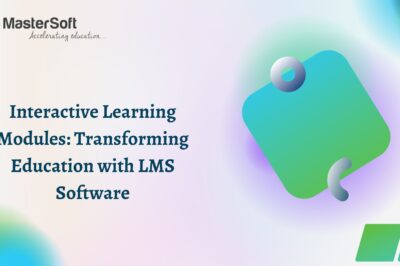Interactive Learning Modules: Transforming Education with LMS Software
In the fast-paced digital era, the landscape of education is undergoing a profound transformation. Traditional teaching methods are giving way to innovative approaches that leverage technology to create dynamic and engaging learning experiences. At the forefront of this revolution are Interactive Learning Modules (ILMs) powered by Learning Management System (LMS) software. This combination is reshaping the way educators teach and students learn, making education more accessible, interactive, and effective than ever before.
The Rise of Interactive Learning Modules:
Interactive Learning Modules, or learning management system, represent a departure from the conventional one-size-fits-all approach to education. These modules are designed to be dynamic and adaptive, catering to diverse learning styles and preferences. Unlike traditional textbooks or lectures, ILMs engage students through interactive content such as multimedia, simulations, quizzes, and collaborative activities. This not only captures the students’ attention but also enhances their understanding and retention of the material.
One of the key advantages of ILMs is their ability to provide personalized learning experiences. With adaptive algorithms, these modules can assess individual progress and adjust the difficulty level or content to meet the specific needs of each student. This personalized approach promotes self-paced learning, allowing students to grasp concepts at their own speed, leading to a deeper understanding of the subject matter.
LMS Software: The Backbone of Interactive Learning:
The effectiveness of Interactive Learning Modules is greatly amplified by the integration of Learning Management System (LMS) software. LMS platforms serve as a centralized hub for creating, managing, and delivering educational content. They provide educators with the tools to design interactive modules, track student progress, and assess performance.
LMS software facilitates seamless communication between educators and students. Through online forums, discussion boards, and messaging systems, students can collaborate on projects, ask questions, and engage in meaningful discussions outside the confines of the traditional classroom. This not only fosters a sense of community but also encourages active participation, critical thinking, and problem-solving skills.
Furthermore, LMS platforms support real-time assessment and feedback mechanisms. Educators can monitor students’ performance, identify areas of improvement, and provide timely feedback. This instantaneous feedback loop is invaluable in addressing learning gaps and ensuring that students stay on the right track.
Breaking Down Geographical Barriers:
One of the most significant advantages of Interactive Learning Modules powered by LMS software is their ability to transcend geographical boundaries. Distance is no longer a barrier to quality education. With the rise of online learning, students can access educational content from anywhere in the world, breaking down traditional constraints and democratizing education.
This global accessibility not only benefits students but also opens up new opportunities for educators. Teachers can reach a wider audience, share their expertise, and connect with students from diverse backgrounds. The cultural exchange facilitated by online learning enhances the richness of educational experiences and prepares students for a globalized world.
Enhancing Engagement and Retention:
Interactive Learning Modules and best lms software in india software are designed to enhance student engagement, a critical factor in the learning process. The incorporation of multimedia elements, gamification, and interactive exercises makes learning more enjoyable and relatable. As a result, students are more likely to stay focused, participate actively, and retain information for longer periods.
Moreover, the analytics and reporting features of LMS software enable educators to gain insights into student behavior and performance. By understanding how students interact with the content, educators can make data-driven decisions to optimize the learning experience. This continuous improvement cycle ensures that educational content remains relevant, effective, and aligned with the evolving needs of students.
The Role of Gamification in Interactive Learning:
Gamification, the application of game elements in non-game contexts, has emerged as a powerful tool within Interactive Learning Modules. By integrating elements such as points, badges, leaderboards, and rewards, educators can create a gamified learning experience that motivates students and makes the learning process more enjoyable.
Gamification not only fosters healthy competition but also encourages collaboration. Students can work together to solve challenges, share insights, and celebrate achievements. This collaborative approach not only enhances social learning but also prepares students for the collaborative nature of the modern workforce.
Challenges and Considerations:
While the benefits of Interactive Learning Modules and LMS software are undeniable, it’s crucial to acknowledge the challenges and considerations associated with their implementation. One of the primary concerns is the digital divide – the gap between those who have access to technology and the internet and those who do not. To ensure inclusivity, efforts must be made to address this divide and provide equal access to educational resources.
Additionally, there is a learning curve associated with adopting new technologies. Both educators and students may need training and support to navigate and make the most of these tools. Institutions must invest in professional development programs to equip educators with the skills and knowledge needed to leverage Interactive Learning Modules and LMS software effectively.
Conclusion:
Interactive Learning Modules powered by Learning Management System software represent a paradigm shift in education. These tools are not merely a technological enhancement but a catalyst for a more inclusive, engaging, and effective learning experience. By breaking down geographical barriers, personalizing learning journeys, and leveraging gamification, education is evolving to meet the demands of the digital age.
As we embrace the transformative potential of Interactive Learning Modules and LMS software, it’s essential to approach their implementation thoughtfully. By addressing challenges, providing support, and fostering a culture of continuous improvement, educators and institutions can harness the full power of these tools to shape the future of education. The journey towards a more interactive, dynamic, and accessible education system has only just begun, and the possibilities are limitless.
